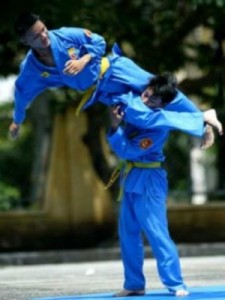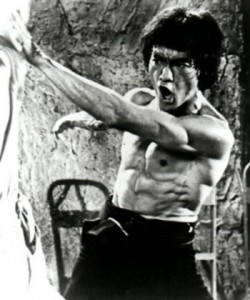Taekkyon
 Taekkyon as well as taekwondo is a traditional form of martial art in Korea. In taekkyon techniques, various movements of the legs and arms are often used, which are more reminiscent of a smooth dance. Taekkyon is a martial art where any punches are forbidden; instead, punches with open hands are used. This type of struggle is more focused on defense than attack. The main task of taekyon is to defeat the opponent using misses and miscalculations of the opponent’s actions, forcing him to retreat or fall to the ground.
Taekkyon as well as taekwondo is a traditional form of martial art in Korea. In taekkyon techniques, various movements of the legs and arms are often used, which are more reminiscent of a smooth dance. Taekkyon is a martial art where any punches are forbidden; instead, punches with open hands are used. This type of struggle is more focused on defense than attack. The main task of taekyon is to defeat the opponent using misses and miscalculations of the opponent’s actions, forcing him to retreat or fall to the ground.
The Korean form of taekkyon martial art is often compared with the technique of fighting in taekwondo or the well-known Chinese martial art of kung fu, but despite this, taekkyon has many features and differences. So, despite the presence of an element of mutual bow before the start of a fight in taekwondo, all movements should be jerky and sharp, while in taekken all movements should be smoother. Slow movements are characteristic of the kung fu technique, while in taekken there are sharp movements with momentary lunges. It is also important to note that the basis of kung fu fighting is the use of fists, and the technique of fighting in taekkyon is based on the palms and their backs, as well as on the simultaneous movements of the legs and arms. And although taekkyon from the outside may seem light and weak like a dance, it is based on great strength, which can cause serious damage to the opponent, and in some cases even kill him.
Today, taekkyon is a very popular sport that can not only temper well, but also train the body. This type of struggle continues to expand its circle of fans, even among women who are happy to engage in it for the sake of entertainment.
Taekyong story
The origin of taekyon began with several drawings of the Koguryeo era, which depicted two people who were sitting opposite one another with arms outstretched in a combat pose. From that moment, the origin of the taekkyon fighting technique began. In the era of Koguryo, such a martial art developed very quickly, and at that time there already existed a large number of trained people who perfectly knew its technique. In the time of Joseon, when sport began to spread widely among the people, taekkyon was very popular. But by the end of the 20th century, athletes who had mastered the technique of fighting taekkyon died, and those who remained could no longer engage in such art. So, in order to perpetuate taekkyon as an element of tradition, it was officially registered as a monument of intangible culture.
Taekyon Features and Practices
The main goal of fighting in taekkyon is not attack, but protection with the help of smooth and natural movements of the legs and arms. Another important feature of taekyon is its musicality and rhythm.
The base position in taekkyon are the spread legs shoulder-width apart, which, while moving, move forward in turn, creating a triangle. The basis of the taekkyon martial art technique is a large number of various techniques, namely: grabbing the opponent’s legs, pushing into the chest with the wrists, grabbing the opponent’s neck, kick with a turn on the cheek, kick with a turn on the hands, an outside kick in, a kick with U-turn, kick in the upper body, as well as grabbing the opponent’s neck with elbows, squeezing the eyes and much more. In addition, it allows the use of distracting maneuvers, such as waving hands and shouting, to mislead the enemy.
Taekkyon Competition
The first taekken competitions that we used to see them today, where in the center of the stadium the athletes stand opposite each other at the distance necessary for the attack, arose after 1991, after experiencing major changes in 1997 and 1998. The winner is the athlete whose opponent touched the ground with any upper body (above the knee), or in the event of a blow to the face. Victory to the athlete can also bring a case in which the opponent’s legs during the attack or during the fight, were above the knees, or if the opponent took more than two steps back and even if he lost his fighting position.
The competition area is a circle or square, consisting of mats with a total area of 8 square meters. The judiciary consists of the main judge, two of his assistants to the main judge, as well as a referee and a person who monitors time. Athletic clothing has a completely standard set – a white or blue uniform with white socks stuffed with cotton.
All ongoing competitions can be divided into children’s, where only children under 10 years old, student, regular, group and private, take part. Each of them can also be divided into men’s and women’s competitions. In addition, there is also a division into classes.
It is important to note that the competition lasts 3 rounds, each of which takes place for three minutes, with a one-minute break. In group competitions there is only one break, which is 3 minutes.




